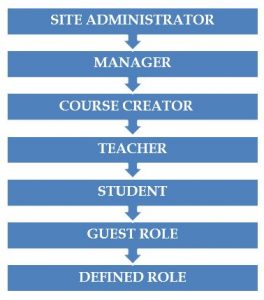Moodle LMS Overview
Moodle (Modular Object-Oriented Dynamic Learning Environment) LMS (Learning Management System) works as a Course Management System (CMS). The term course is widely used in this LMS. Each and every course is assigned to a teacher qui has several rights to control or edit the course.
The course teacher can use various activities with respect to the teaching-learning process. The term activities and resources play an important role for the teacher. It decides the way of giving input to the students and is very helpful while assessing the participants.
Rights Permission Hierarchy
The first thing a teacher needs in the LMS is a course. The course creation process can be done by the course creator or manager of the particular site. There are several roles that have different sets of rights. The site administrator is the topmost role, which has all sorts of rights to do the changes in the allowed site.
As far as access rights are concerned, the second-most important one is the manager role. This role has a more limited set of rights than the site administrator. For every role, the hierarchical rights can be set by the site administrator. For example, the kind of editing access for the course creator can be set. Based on that, a course creator can give rights to the lowest-level roles.

The course creator can create the courses and structure the hierarchy for the teachers. One of the active roles in the Moodle LMS is the teacher role. A teacher can use a lot of the available activities and resources. Within a mapped course, a teacher can perform many editing processes within the activities and resources that they have created.
Next is the student role. This role has only limited rights. No editing permission is given for this role since the LMS is developed to assess the performance of the students or participants. Finally, a guest role and a defined role are given to the participants based on the requirements. It is decided by the site administrator.
Activities
There are a lot of activities that can be given to the participants to ensure their learning process. One of the most frequently used activities is quizzing.
- Quiz Activity
A quiz activity is used to test the student’s performance by giving different types of questions. It comprises a set of instructions and the exact time to appear for the assessment. Access restrictions can be given to the quiz. For example, if a student or participant answered a feedback question, he or she may appear for the quiz activity.
Reviewing the quiz after and before completion is possible. All these sets of criteria can be set by the teacher. Once the criteria are set, the quiz activity will be created.
1.1 Question Types
- Choice based
- True/False
- Match the following
- Short answer
- Numerical answer
- Select missing keywords
- Embedded answers
- Essay (Auto grade)
All the question types have a standard template that will be available in MS Office Word as an add-on. MoodleQuiz is an add-on used in MS Word to create the questions.
Once the questions are created with the available template, the file should be saved in the system. Under the quiz category, the file can be uploaded, and it will be available for the participants as per the mentioned time.
It performs auto-valuation for choice-based questions since the correct answer is set with the value “1” while creating the questions. For essay-type questions, the teacher can do the manual valuation. The statistical analysis can be done with automatic valuation.
There is a provision for the participants to review the questions and correct their answers after the completion of the quiz. The cumulative marks for a particular course can be viewed by the participants, and the respective teacher can analyze the performance for the betterment of the participants.
- Feedback Activity
In the feedback activity, the voting from the participants is obtained in different forms. The voting may be in the form of choices or typed information. It allows the administrator or course teacher to conduct surveys.
Rather than choosing the predefined questions, the course teacher can create the survey questions on their own. There are different types of feedback available under LMS: informal feedback, formal feedback, summative feedback, formative feedback, etc.
A standard template can be created and saved in the activity rather than creating the same type of questions each and every time.
- Turnitin Assignment Activity
With the help of the Turnitin assignment activity, the participants can submit their assignments within the prescribed due date. The details of the assignment and other extra information are displayed inside the activity itself.
After the submission is made, the activity checks for plagiarism and reports the same to the course teacher. Based on the similarity percentage, the course teacher can award the marks. The cumulative reports of all the participants can be downloaded in Excel.
With reference to the above-stated activities, Moodle LMS provides a variety of benefits to end users through its e-learning strategy. The future generation can adopt paperless education. Moodle increases the curiosity among the user community to learn the technology and courses in an efficient manner. (Source: https://moodlelmsadmincourseinstructor.blogspot.com/2022/08/moodle-lms-overview-chapter-1.html)
Image Source: https://e7.pngegg.com/pngimages/1005/937/

